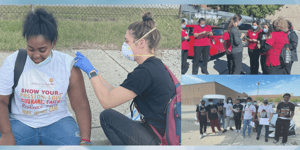Tracking COVID-19: Equipping Local Leaders with Data to Protect Health
December 30, 2020 Posted by AHW Endowment

To learn more about this funded project, click here.
At the onset of the COVID-19 pandemic, it was clear that Milwaukee County was being hit particularly hard. In May, the county was home to 39% of the state’s confirmed cases and 56% of fatalities, despite only making up 16% of the state’s total population.
To address the need for action, the County’s Office of Emergency Management initiated the Milwaukee County Unified Emergency Operations Center to monitor and support the countywide response to COVID-19. But their work was met with an immediate challenge: the need for focused data analysis to help guide decision-making. In order to address local impact, the group needed local data analyzed and interpreted by epidemiologists—experts in investigating the incidence, occurrence, and possible control of diseases and other health issues—who could assess the current impact and provide critical analysis that would help leaders monitor and respond appropriately.
Supported by a $145,168 AHW rapid response grant, Kirsten Beyer, PhD, MPH, associate professor and Mallory O’Brien, PhD, assistant professor in the division of epidemiology in the Institute for Health & Equity at the Medical College of Wisconsin, began leading a team with the expertise to provide data to the Milwaukee County Office of Emergency Management and its Unified Emergency Operations Center, as well as MCW leadership, 11 Milwaukee County health departments, and seven counties across southeastern Wisconsin.
“When COVID-19 hit, we immediately began to reach out to partners and obtain and analyze data, but our capacity was limited,” said Beyer. “The grant allowed us to increase our capacity and responsiveness. The AHW award really jumpstarted something much bigger.”
Using predictive modeling, the team began analyzing data from several sources to understand the current situation and anticipate the virus’s future impact, creating reports that included data visualization detailing a variety of factors like infections, deaths, and available hospital beds to help leaders across the municipalities and organizations make critical decisions and communicate with the public and the media.
So far, the data has informed local leaders as they make key decisions such as determining the number of beds that would be needed at the Alternate Care Facility at Wisconsin State Fair Park, and by school districts as they decided whether or not to resume in-person classes. When the project team noticed fewer tests were being reported on the north side of Milwaukee, they notified the city, who responded by reaching out to community health workers and others to make a bigger push for testing.
The team has maintained communication with community leaders and adjusted reports to meet different needs. They have provided standard daily and weekly reports, as well as reports focused on social determinants of health, children, and the impact on underserved populations, including Milwaukee’s Hispanic and Black communities. While the project originally focused on Milwaukee County, the team has expanded its reporting to include Washington, Ozaukee, Waukesha, Walworth, Racine, and Kenosha counties.
“We have really been able to support local public health,” said O’Brien. “We can provide a near real-time response in an ongoing way to help with decision making.”
“We have seen clear patterns by socioeconomic status, race, and ethnicity in terms of who is getting infected, hospitalized, and dying. It’s a classic story of health disparities.” – Kirsten Beyer, PhD, MPH
The goal is to provide necessary data that allows health experts and municipal leaders to monitor, predict, and prevent the spread of COVID-19, especially among the region’s most vulnerable populations.
“Health equity is the heart of this whole project,” said Beyer. “At the beginning we saw different waves occurring at different times for various groups of people. We have seen clear patterns by socioeconomic status, race, and ethnicity in terms of who is getting infected, hospitalized, and dying. It’s a classic story of health disparities.”
Beyer notes that the burden of COVID-19 changes is dependent on people’s behavior and policy. The team is now preparing to evaluate the effect that holiday gatherings will have on southeast Wisconsin’s communities.
The team is already looking ahead at opportunities for future analysis and future funding, including evaluating the effectiveness of various policies and monitoring the rollout of the vaccine.
“If we are not keeping close tabs on the vaccines as they roll out, we may see a magnifying of disparities,” said Beyer. “We often see with new technologies and new health care opportunities—they often go to the people who are resourced before the people who are not.”
According to Beyer, this kind of data analysis is fundamental to decision making that protects public health.
“I think a lot more people in the world know the word epidemiology now than before the pandemic,” said Beyer. “Hopefully that will bring some new people into the public health and healthcare fields who recognize the value in this work and want to get involved.”




